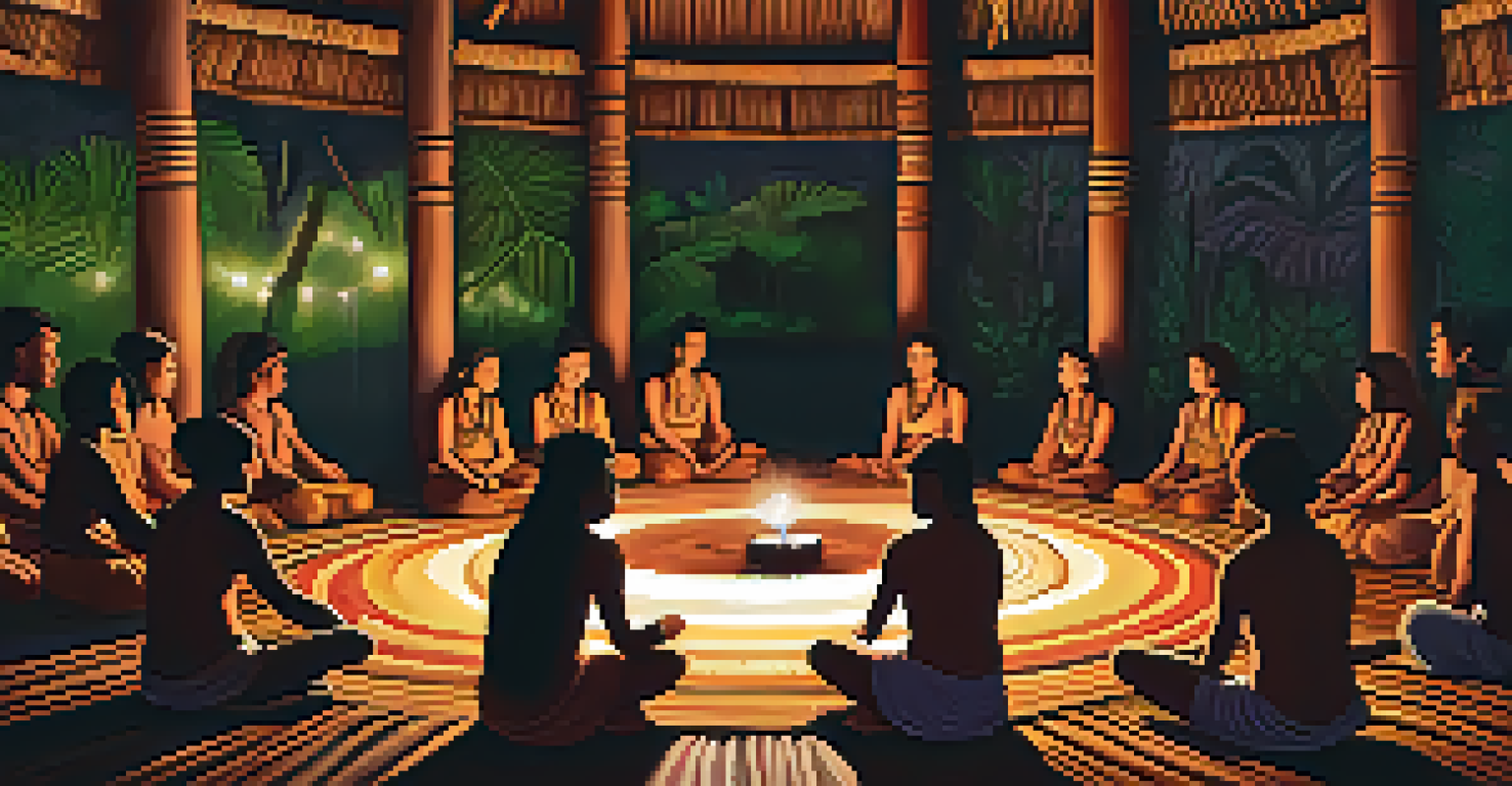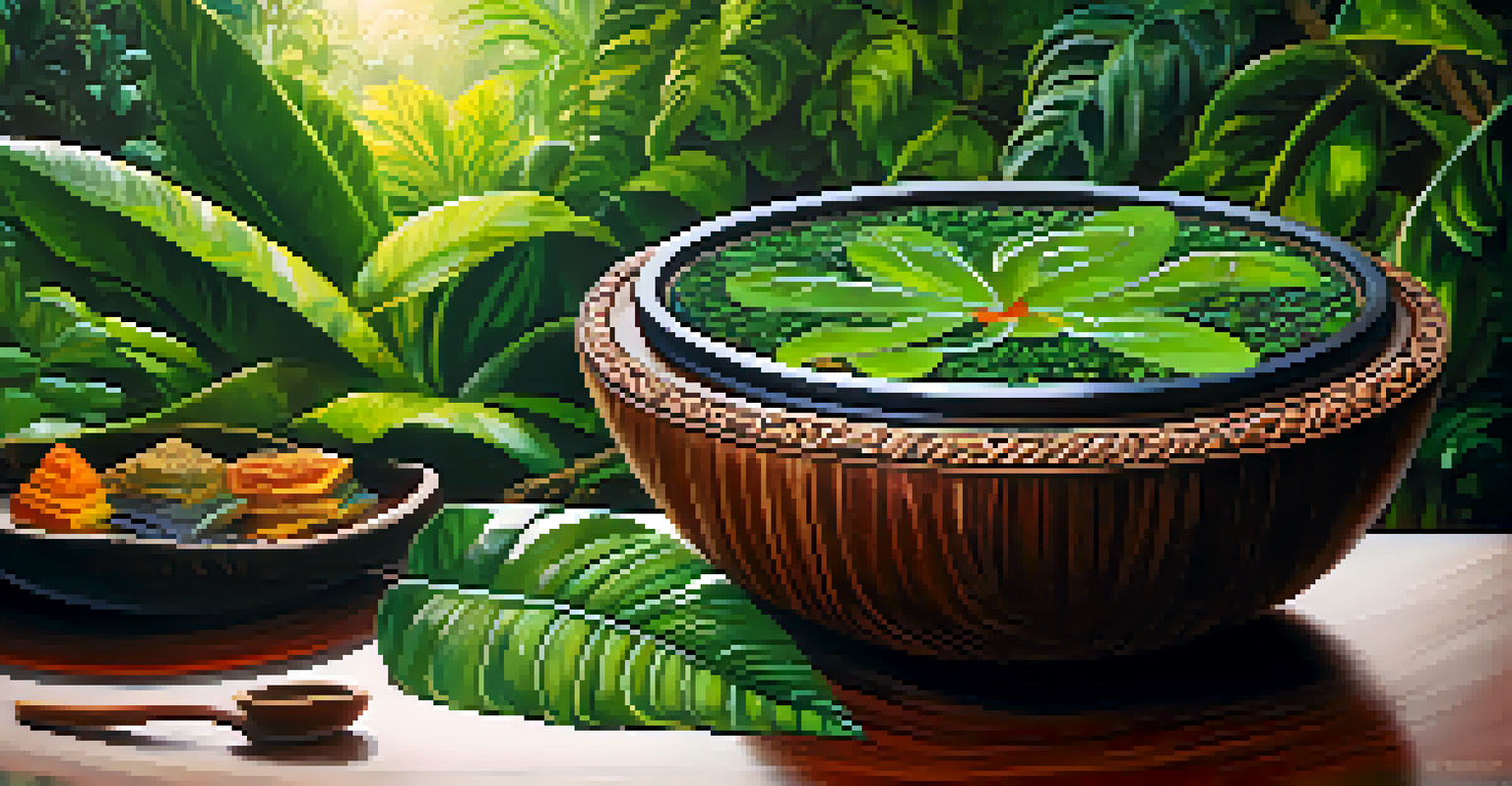Ayahuasca: A Journey Through the Amazonian Cultural Landscape

Introduction to Ayahuasca and Its Cultural Roots
Ayahuasca is more than just a plant-based brew; it's a profound cultural experience that originates from the Amazon rainforest. For centuries, indigenous tribes have utilized this sacred concoction in their spiritual and healing practices. The brew, made from the Banisteriopsis caapi vine and other plants, serves as a gateway to altered states of consciousness.
The experience of Ayahuasca is not just a personal journey; it is a communal one that connects us to the wisdom of our ancestors and the natural world around us.
In these states, participants often embark on deeply personal journeys that connect them to their ancestors and the natural world. These experiences are not merely recreational; they have a rich history intertwined with the traditions and beliefs of the Amazonian people. Understanding this context is essential to appreciating the significance of Ayahuasca today.
As Western interest in Ayahuasca grows, it’s crucial to approach it with respect for its origins and cultural significance. The journey begins not just in the brew itself, but in recognizing the stories and practices that have surrounded it for generations.
The Role of Ayahuasca in Indigenous Healing Practices
For many indigenous groups, Ayahuasca is a cornerstone of their healing practices. Shamans, or healers, use the brew to diagnose and treat ailments, both physical and spiritual. This ancient knowledge is passed down through generations, ensuring that the cultural heritage remains intact.

The ceremonies often take place in a communal setting, where participants share their experiences and support one another. This communal aspect highlights the interconnectedness of the community, fostering bonds that go beyond individual healing. It's a vivid reminder that health and wellness are not solely individual pursuits but collective journeys.
Cultural Roots of Ayahuasca
Ayahuasca is deeply rooted in Amazonian culture, serving as a sacred tool for spiritual and healing practices among indigenous tribes.
In these ceremonies, the shaman guides the participants through their experiences, often singing icaros—traditional songs that help navigate the spiritual landscape. This ritualistic approach reinforces the belief that healing is as much about the mind and spirit as it is about the body.
Ayahuasca's Spiritual Significance and Symbolism
The spiritual dimensions of Ayahuasca are profound and multifaceted. Many believe that the brew allows individuals to connect with a higher consciousness or even the spirit of the plants themselves. This connection often leads to profound insights and personal revelations.
Ayahuasca serves as a bridge between the spiritual and the scientific, allowing us to explore the vast terrain of consciousness and healing.
The symbolism associated with Ayahuasca is rich, representing themes of rebirth, transformation, and interconnectedness. Participants frequently describe experiences of seeing vivid visions that convey deep spiritual messages. These visions can serve as a mirror, reflecting both inner struggles and aspirations.
Understanding these spiritual themes can enhance the experience for those who partake. By approaching Ayahuasca with an open heart and mind, participants may find themselves on a transformative path toward greater self-awareness and connection to the universe.
Modern Interest in Ayahuasca: A Global Phenomenon
In recent years, Ayahuasca has gained immense popularity outside the Amazon, drawing seekers from all over the globe. Many are looking for alternative ways to heal emotional trauma, enhance creativity, or simply explore consciousness. This growing interest has led to the establishment of retreat centers worldwide.
However, this surge in popularity also raises ethical concerns about cultural appropriation and the commercialization of sacred practices. It's vital for participants to educate themselves about the cultural context and to approach these experiences with respect and humility. Engaging with indigenous communities and learning from them can foster a deeper understanding.
Growing Global Interest in Ayahuasca
The rising popularity of Ayahuasca outside the Amazon raises ethical concerns about cultural appropriation and the need for respectful engagement.
As people embark on their Ayahuasca journeys, they should be mindful of the importance of maintaining the integrity of this tradition. This includes supporting indigenous voices and practices that honor the cultural roots of the brew while seeking personal transformation.
The Science Behind Ayahuasca: What Research Shows
Scientific interest in Ayahuasca has grown, with researchers exploring its potential therapeutic benefits. Studies have suggested that the brew may help alleviate symptoms of depression, anxiety, and PTSD. The active compounds in Ayahuasca, such as DMT, have been shown to promote neuroplasticity, the brain's ability to form new connections.
However, while the preliminary findings are promising, more rigorous research is needed to fully understand its effects. Participants must also consider the psychological risks associated with intense experiences. It’s crucial to approach Ayahuasca with care, ideally under the guidance of experienced facilitators.
This intersection between science and spirituality opens up fascinating discussions about the nature of consciousness and healing. As research continues, it may pave the way for more integrated approaches to mental health, marrying traditional wisdom with modern therapeutic practices.
Preparing for an Ayahuasca Ceremony: What to Expect
Preparing for an Ayahuasca ceremony requires both mental and physical readiness. Many facilitators recommend a period of dietary and lifestyle adjustments leading up to the experience, often referred to as a 'dieta.' This may include avoiding certain foods, alcohol, and drugs, which helps to purify the body and mind.
Participants should also take time to set intentions for their journey. Reflecting on personal goals and what they hope to achieve can provide clarity and focus during the experience. This intentional approach can enhance the overall journey, making it more meaningful.
Therapeutic Potential of Ayahuasca
Research suggests that Ayahuasca may offer therapeutic benefits for mental health conditions, though more studies are needed to fully understand its effects.
On the day of the ceremony, participants can expect a structured and respectful environment. The ambiance is often tranquil, with dim lighting and calming music. This setting allows individuals to feel safe and supported as they embark on their unique journeys through the spirit of Ayahuasca.
Reflections on the Ayahuasca Experience and Integration
After an Ayahuasca ceremony, participants often find themselves in a period of reflection and integration. The insights gained during the experience can be profound, but they require time to process. Many people journal, meditate, or share their experiences with others to help make sense of their journeys.
Integration is crucial because it bridges the gap between the transformative insights of the ceremony and everyday life. It's about taking the lessons learned and applying them in a practical way, fostering personal growth and change. This process can be supported by community, therapy, or continued engagement with spiritual practices.

Ultimately, the Ayahuasca experience can serve as a catalyst for deeper understanding and connection—not just to oneself, but to the world around us. By embracing these insights, individuals can cultivate a more meaningful existence, enriched by their journeys through the Amazonian cultural landscape.